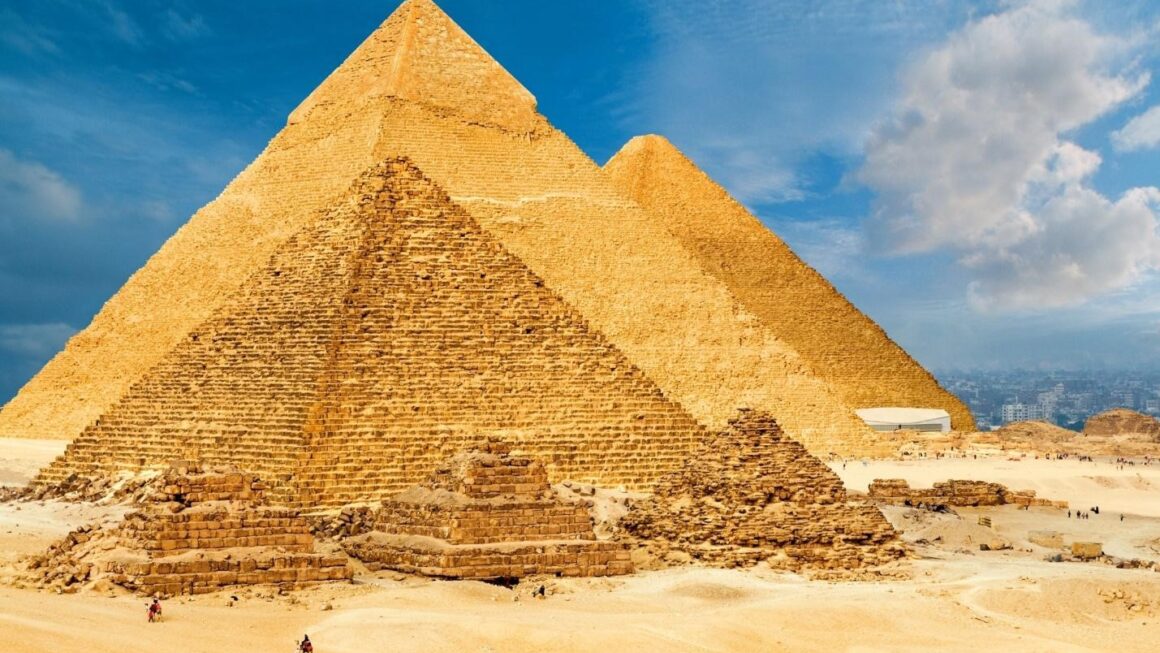Egypt is home to one of the world’s oldest civilizations, a country with important trade routes between capital-rich Europe and resource-rich Asia. Egypt is located in North Africa. It has a unique EGP because it lies on the border of two continents and two parts of the world. Most of Egypt is geographically located in Africa, less (northeast) – on the Sinai Peninsula in Asia. The country is washed in the north by the waters of the Mediterranean Sea of the Atlantic Ocean, in the northeast – the Red Sea of the Indian Ocean. The seas are connected by a channel built in the second half of the XIX century.
Egypt borders three countries. Two of them are the Arab countries of North Africa, which are developing countries and allies of Egypt in the League of Arab States: Libya – in the west, Sudan – in the south. In its Asian part in the northeast, Egypt shares borders with the highly developed state of Israel and part of the Palestinian Authority.
Egypt is known for its remarkable Giza pyramids, which form the so-called “ensemble.” Read more about this below.
The Giza Pyramid Ensemble
The pyramids of the pharaohs Khufu (Cheops), Khafra (Khafre), and Menkaur (Mycerinus, 27th century BC) in Giza were called one of the seven wonders of the world. In the minds of people, they are still identified with the art of Egypt, the nature and appearance of this country. Built of light stone in the middle of the desert, they impress with their size and severity.
A huge mass of pyramids composed of powerful stone blocks, conquered by an extremely simple and clear idea. Each of the pyramids is a square in plan, and its sides are isosceles triangles. In the blinding sun, the falling shadows further emphasize the rational clarity of these buildings, the simplicity of which was generated not by the poverty of imagination but by the great skill of generalization, which has been honed over the centuries.
The arrangement of pyramids in groups, characteristic of the Egyptian architecture of the Ancient Kingdom, shifts the viewer’s attention from a separate pyramid to the whole, the compositional part of which is each pyramid.
The Grand Pyramid of Cheops: General Characteristics
The most grandiose of the three is the Pyramid of Cheops, built under the direction of architect Hemiun. The artificial mountain, which covers an area of five hectares, has no intermediate connecting divisions in the processing of its mass and is sharply opposed to man. Its height is about 147 m, the length of the lower face – 233 m.
According to the description of Herodotus, thousands of people built the road for the transportation of stone slabs for ten years, and then, after another twenty-five years, they built the pyramid itself. The pyramid consists of two million three hundred thousand blocks, each weighing 2.5 to 30 tons. The entire surface of the Pyramid of Cheops was lined with polished limestone slabs, which gave its appearance a special crystal clarity. Inside were only a small chamber lined with granite, which housed a sarcophagus with a mummy, corridors, and narrow ventilation ducts.
The section of the Pyramid of Cheops is a triangle consisting of two so-called magical or sacred Egyptian triangles. From afar, you can see not a real triangle of the face of the pyramid, but its perspective reduction, similar to a section, if you stand in front of the middle of one of the faces. The real triangle could be seen only if you look at the pyramid from a high place. However, the proportions of the Pyramid of Cheops are not canonical. The proportions of the pyramid of Cheops are unique.
The Sphinx as a Complement to the Giza Pyramid Ensemble

The connection between the pyramid and the desert is deepened by the location of a huge sphinx near the group of pyramids in Giza. A giant sphinx figure standing on a straight axis leading to the Pyramid of Khafre complements the ensemble. It combines the stern face of the pharaoh with the body of a lion. The sculpture of the sphinx is carved from the massif of a single rock; the sphinx has a wide-open gaze, directed to eternity, which sees nothing earthly.
According to scientists, the Egyptians saw in the sphinx a real creature born of formidable nature. The three great pyramids and the sphinx form a single composition in Giza. The sphinx enhances the merger of the whole group of pyramids with the desert. It creates an extra spatial layer between the spectator and the pyramids. The sphinx itself, due to its large size and connection with nature, requires contemplation of it from afar, which further distances the viewer from the pyramid.



